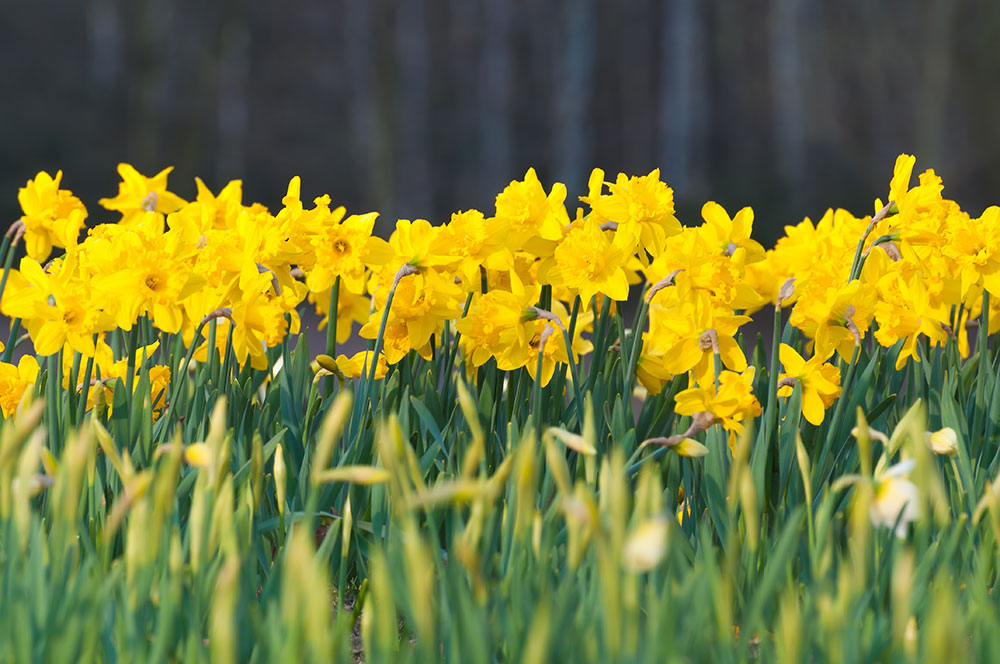Daffodils are one of the first flowers we learn to recognize as children. Maybe we called them “Daffy-down-dillies” or “Jonquils.” Their correct botanical name is Narcissus; the correct common name is ‘daffodil’. Jonquil refers to a specific kind of Narcissus/Daffodil.
Daffodils are divided into thirteen different groups, depending on flower shape. They come in large showy “trumpet” daffodils like Dutch Master—towering at 18 to 20 inches tall to tiny little specie daffodils topping out at 4 to 6 inches.
There are daffodils, like February Gold and Rijnveld’s Early Sensation which will bloom as early as February and even a few, like Actaea, Thalia, and Pheasant’s Eye which will bloom early May. Most others will bloom solidly mid-spring—March/April.
Around here, daffodils are especially prized because deer don’t eat them! Neither do squirrels or voles. Now, that doesn’t mean they don’t occasionally dig them up while they’re burying acorns, but just tuck them back in and sprinkle a little crushed red pepper flake around to ensure they don’t do it again.
How to Plant
Daffodils have a reputation for tolerating shade, however….to get them to perform their best, give them a half-day of sun or more. On the other hand, if you plant some earlier blooming daffs, they’ll be up, blooming, and done before the trees leaf out so they’ll do okay.
After your daffodils bloom, the foliage needs to grow for a while so it can “fatten up” the bulbs for next year’s flowers. Never ever remove daffodil foliage until it has begun to die back on its own. Removing foliage prematurely can affect whether or not they bloom next year.
Do You Need to Divide?
Because daffodil bulbs split and divide readily, after a few years, you may find you have a patch that used to bloom great but now sends up only leaves and no flowers. This may be a sign that you need to go in and dig them up and divide, giving them a little more room.
The best time to do this would be in late summer/early fall but, since the foliage has died down then, it can be hard to know where to dig. The next best time would be to dig and divide in early summer when the foliage has yellowed but is still there to let you know where to dig.
Dig the clumps of bulbs up, separate into individual bulbs (you can leave any babies smaller than a quarter attached) and replant six or more inches apart.
When to Feed
The best time to feed daffodils is in mid-October (which is also the best time to plant them). This is when the bulbs are “waking up” after their summer dormancy and beginning to grow roots for the winter.
And William Wordsworth Said–
“And then my heart with pleasure fills
And dances with the daffodils.”
Come in and let me help you select daffodils to dance within your garden.


Great read. Thanks.
I dug up ALL daffodils last year (previous homeowner planted heirloom daffodils that are just gorgeous – but they were all mishmash together in random orders but not in a cool way.)
Last spring, I numbered the 10 varieties that are in the backyard as they bloomed, and put stakes in the ground with those numbers and took pictures (numbered those in ‘edit’ mode) of what they look like so I could ATTEMPT to choreograph planting them all BACK in the ground this Fall.
In theory, this will be great. Lol. We shall see. Gardening is always a surprise. Right?
Wendy–Gardening is indeed always a surprise–and sometimes even an adventure. One of the many reasons I love it!